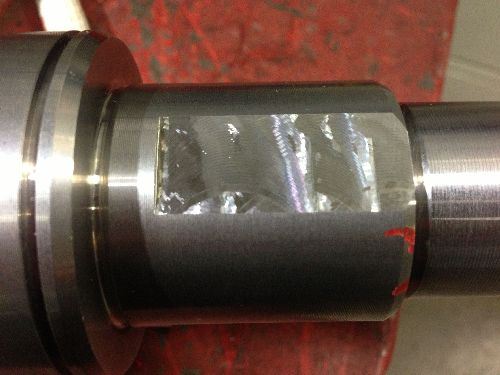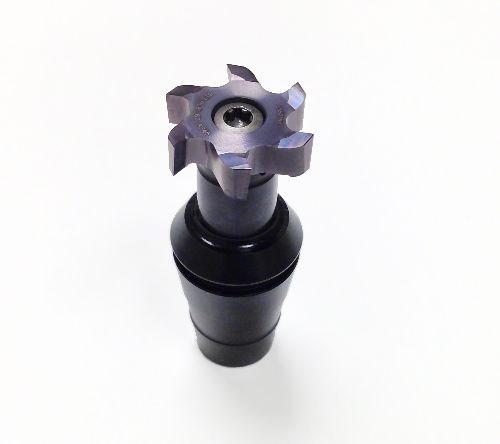Cutting Tool Helps Automotive Manufacturer Implement Design Change
Horn USA’s Mini Mill helped Machine Tool and Gear mill a flat at 90 degrees from other operations.
Share



To accommodate a design change in an automotive part, Machine Tool and Gear (MT&G) of Owosso, Michigan, needed to find a cost-effective way to machine a feature at 90 degrees from other operations. The company soon found that not all tooling could withstand the demands of the application or provide the desired surface finish. However, after purchasing a new cutting tool from Horn USA (Franklin, Tennessee), MT&G was able to cut the part and achieve the desired surface finish without investing in a more expensive solution.
MT&G manufactures more than 112,000 truck shafts each year, among other automotive parts, in its 70,000-square-foot facility. These shafts are produced in a work cell built around a Mori Seiki NH 4000 horizontal machining center. Recently, the design of one of these shafts changed to include a difficult-to-access feature—a flat area that needed to be machined at 90 degrees from other operations.
Manufacturing Engineer Jeff Ochodnicky’s first thought was to use another machine to mill the flats, but that was a major expense the company wanted to avoid. The new machine would need to be located elsewhere in the plant because there would be no room within the existing work cell, and reconfiguring the cell would be a major undertaking. Also, taking the part out of the current cell and moving it to a new machine would require downtime and new fixturing along with additional labor costs to move setup and run the new program.
Instead, MT&G decided to use two 90-degree milling heads to machine the flats. Soon, however, the company realized the tool inserts showed excessive wear and produced an unacceptable surface finish. Working with the insert supplier, the company tried different depths of cut, inserts, spindle speeds and feed rates without success. The inserts simply couldn’t mill a 1.500-inch-long flat 0.060-inch deep on a shaft using a 0.854-inch-diameter cutter hanging more than 10 inches out of the spindle.
Finally, Mr. Ochodnicky asked for help. He called Phil Horn from local distributor PF Markey, who brought in Brett Kischnick, an application/sales engineer from Horn USA.
According to Mr. Kischnick, the task wasn’t easy, but he was confident he could accomplish it using the right tool. Instead of the staggered-flute-design cutter MT&G was attempting to use, which caused a pushing and pulling during the cut, he suggested using a Mini Mill insert from Horn USA. The Mini Mill would apply all cutting forces downward and free up the cut by using a positive axial helix.
Another hurdle to overcome was achieving a 30-microinch Ra surface finish without an additional step between two passes—a critical issue for this process. Mr. Kischnick addressed this challenge by eliminating even more cutting pressure by reducing the teeth in the cut from six to three, increasing the surface feet per minute, and making a rough cut first—leaving 0.002 inch for a finish pass. He also moved the finish pass away from the 0.060-inch-tall side wall left from the rough pass. Because multidirectional tool pressure causes a poor surface finish, relieving the side pressure by just a few thousandths of an inch frees up the cut, which provides a better finish, he says. These adjustments produced a 15- to 20-microinch Ra finish without adding a step between passes.
In the end, Mr. Kischnick settled on the final running parameters of 715 surface feet per minute, 0.058-inch depth of cut for roughing and 0.002 inch for finishing, and 0.004-inch IPT for roughing and 0.002-inch IPT for finishing.
“I believed in the 90-degree milling head approach, but I must admit I was beginning to question myself until Mr. Kischnick showed up,” Mr. Ochodnicky says. “It took a while to dial in, but he kept fine-tuning until we achieved the goal. I’d never worked with Horn USA before, but I was very impressed with their knowledge and how they took the time to help solve the problem. As a result, we’ve saved the expense of buying another machine tool and kept additional labor costs out of our process.”
Related Content
Nidec Universal Head Enables Versatile Machining
The compact universal head enables better accessibility between the tool and the workpiece, as well as improved surface-finish quality, greater motion range and high-efficiency machining under ideal machining conditions.
Read MoreSandvik Coromant Milling Tool Boosts Productivity in Steel Machining
CoroMill MR80 is designed for challenging roughing operations in a wide range of face and profile milling applications in steel and stainless steel.
Read MoreSPC Innovations Milling Attachments Boost Productivity
PMTS 2025: SPC Innovations Inc. showcases multispindle attachments that can increase productivity, reduce secondary operations and enable for quick job changeovers.
Read More
































